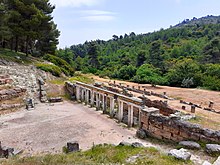
Back Oracle d'Amfiarau Catalan Amphiareion CEB Amphiareion German Αμφιαράειο Greek Anfiareo Spanish Amfiaraion Finnish Amphiaréion d'Oropós French Oracolo di Anfiarao Italian Amphiareion van Oropus Dutch Храм Амфиарая Russian
Άμφιάρειον Ωρωπού | |
 View of the ancient theater. | |
| Location | Markopoulo Oropou, Attica, Greece |
|---|---|
| Region | Attica |
| Coordinates | 38°17′29″N 23°50′44″E / 38.29139°N 23.84556°E |
| Type | Sanctuary |
| History | |
| Founded | 5th century BCE |
| Periods | Classical to Roman |
| Satellite of | Athens |
| Site notes | |
| Condition | Ruined |
| Ownership | Public |
| Management | 2nd Ephorate of Prehistoric and Classical Antiquities |
| Public access | Yes |
| Website | Amphiareio, Oropos |
The Amphiareion of Oropos (Greek: Άμφιάρειο Ωρωπού), situated in the hills 6 km southeast of the fortified port of Oropos, was a sanctuary dedicated in the late 5th century BCE to the hero Amphiaraos, where pilgrims went to seek oracular responses and healing. It became particularly successful during the 4th century BCE, to judge from the intensive building at the site.[1] The hero Amphiaraos was a descendant of the seer Melampos and initially refused to participate in the attack on Thebes (detailed in the Seven Against Thebes of Aeschylus) because he could foresee that it would be a disaster.[2] In some versions of the myth,[3] the earth opens and swallows the chariot of Amphiaraos, transforming him into a chthonic hero.[4] Today the site is found east of the modern town Markopoulo Oropou in the Oropos municipality of Attica, Greece.
The sanctuary is located 37.2 km NNE of Athens[5] at a sacred spring; it contained a temple of Amphiaraos (with an acrolithic cult statue), as well as a theater, stoa, and associated structures. The temenos extended for some 240 metres northeast from the Temple of Amphiaraos (hence Amphiareion) along a streambed. The cult, which was both public and private, dates to the 5th century BCE.[6] There was an upswing in the sanctuary's reputation as a healing site during the plague that hit Athens in the late 5th BCE. Herodotus relates that the oracular response of this shrine was one of only two correct answers to the test put to them all by the Lydian king Croesus.[7] There were many dedications from Greeks, notable Romans, and others, many with inscriptions.[8] On the southeast side of the streambed there are extensive remains of domestic structures as well as an unusually well-preserved clepsydra.
At the Amphiareion, in addition to the presumed annual festival, Greater Amphiareia were celebrated in an agonistic festival of athletic games, every fifth year. Two reliefs of the late 5th-early 4th century BCE seem to provide the earliest attestations of the festival games; there is an inscribed catalogue of victors at the Greater Amphiareia that dates before 338 BCE.[9]
Amphiaraos was also worshipped at the site of Rhamnous about 17.5 km southeast, as well as at Athens, Argos, Sparta, and other sites. The cult at the Amphiareion came to an end with the outlawing of non-Christian worship in the Theodosian decrees at the end of the 4th century CE.
In 414 BCE, Aristophanes produced a comedy, Amphiaraos, of which fragments survive as quotations.[10]
- ^ V.C. Petrakos 1968:68-70, noted by Eran Lupu, "Sacrifice at the Amphiareion and a Fragmentary Sacred Law from Oropos", Hesperia 72.3 (July 2003:321-340).
- ^ The Roman poet Statius wrote an epic poem on this myth in the 1st century CE.
- ^ Pindar, Ninth Nemean Ode.
- ^ Pausanias 1.34.2
- ^ The site is described for the non-specialist by E. Melas, in Temples and Sanctuaries of Ancient Greece: A Companion Guide, Melas, editor, (London: Thames & Hudson) 1973.
- ^ Two fragmentary fourth-century inscribed sacred laws reflecting the ritual and votive reliefs (Eran Lupu 2003) supplement Pausanias' description of the incubation, practiced in the second century CE by incubation on a sacrificed ram's fleece.
- ^ Histories, 1.47-49: Croesus asks what he will be doing on a predetermined day, when he was boiling a tortoise and a lamb in a bronze pot with bronze lid. The oracle's answer is, in contrary to that of Delphi, not preserved (§49) but Herodotos does say that "he [Croesus] believed that from there [Amphiareionic oracle] too he had received a true answer".
- ^ In Histories, 1.92.2, Herodotus says that Croesos made a dedication at the Amphiareion.
- ^ Lupu 2003:322 note 5
- ^ A.B. Petropoulou, "The Eparche documents and the early oracle at Oropus" Greek, Roman and Byzantine Studies 22 (1981:57f).
